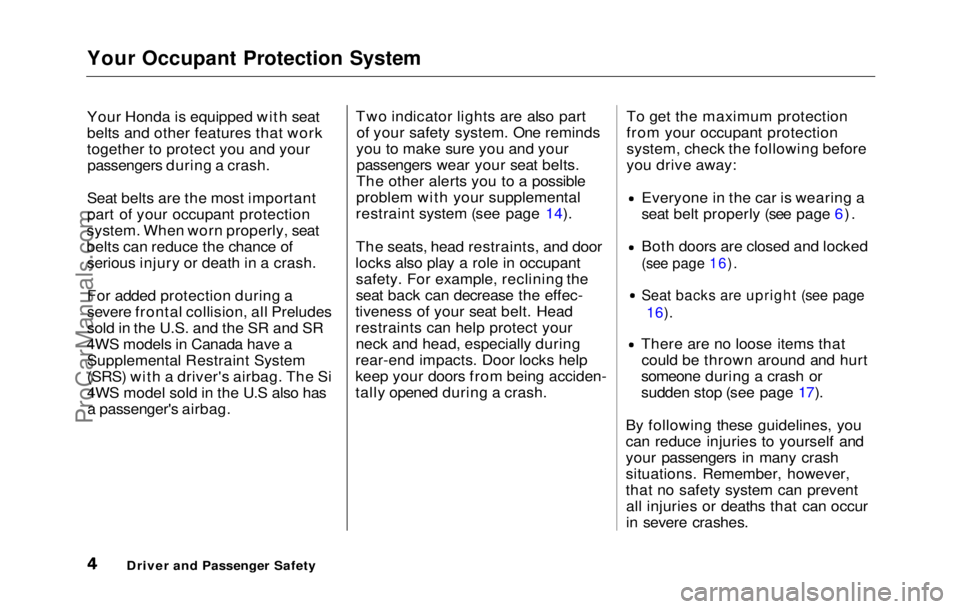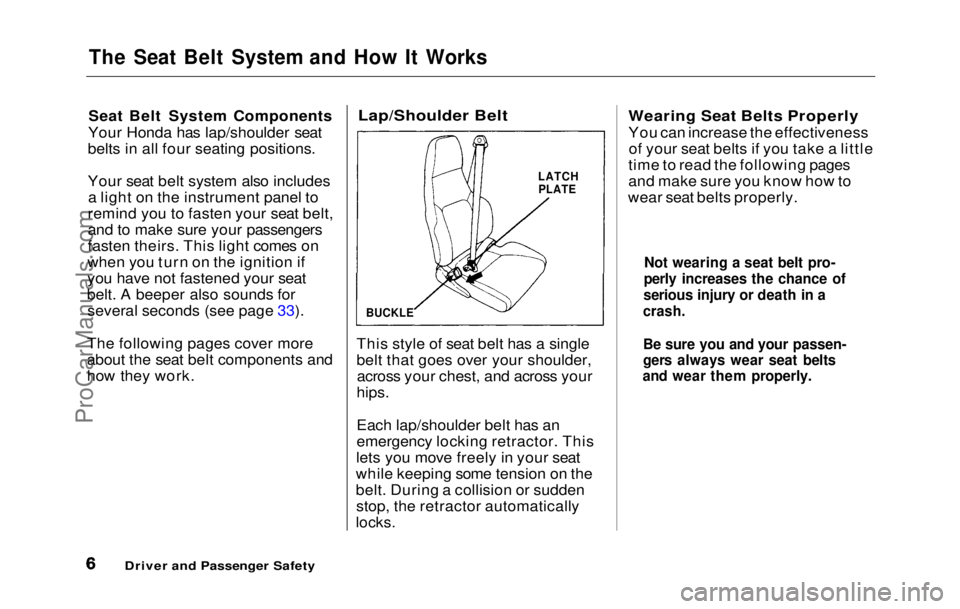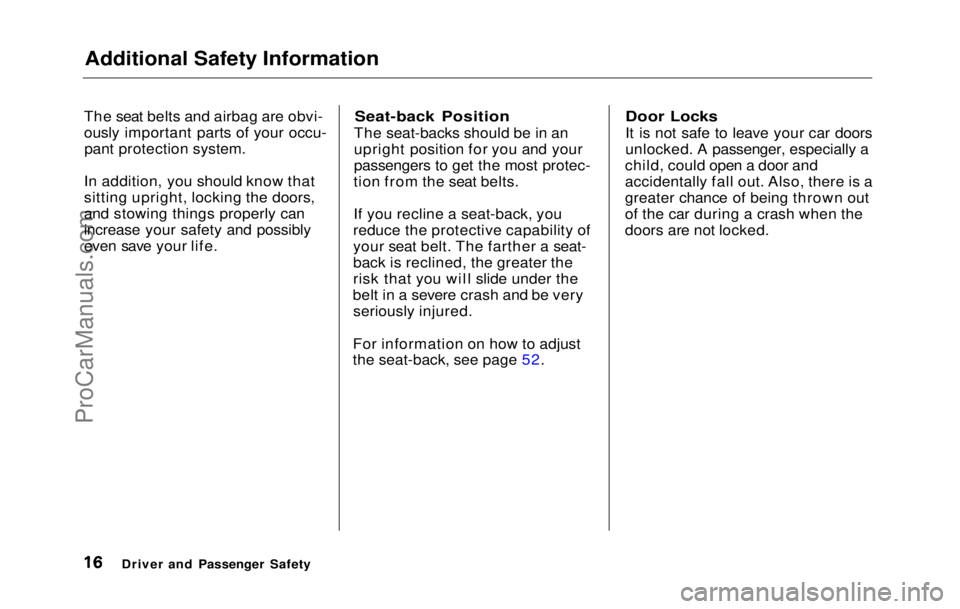1992 HONDA PRELUDE lock
[x] Cancel search: lockPage 4 of 225

Driver and Passenger Safety
This section gives you important
information about occupant protection. It shows how to use seat
belts properly. It explains the Supplemental Restraint System.
And it gives useful information about how to protect infants and
children in your car. Your Occupant Protection
System........................................ 4
The Seat Belt System
and How It Works.................... 5
Why Wear Seat Belts................... 5 Important Safety Reminders..... 5
Seat Belt System Components... 6
Lap/Shoulder Belt........................ 6
Wearing Seat Belts Properly...... 6
Wearing a Lap/Shoulder
Belt ............................................. 7
Advice for Pregnant Women..... 8 Seat Belt Maintenance................ 9
Supplemental Restraint System.. 10 Important Safety Reminder..... 11
How the Driver's Airbag
Works........................................ 12
How the Passenger's Airbag
Works........................................ 13
How the SRS Indicator Light
Works ...................................... 14
System Service.......................... .
14
System Service Precautions..... 15
Additional Safety Information .... 16 Seat-back Position..................... 16
Door Locks.................................. 16 Storing Cargo Safely ................
17
Driving wit
h
Pets....................... 17
Child Safety..................................... 18
Where Should Children Sit?..... 18
Important Safety Reminders... 19
General Guidelines
for Restraining Children Under 18 kg (40 Ibs)............... 19
Restraining an Infant Who Weighs Less Than 9 kg (20 Ibs)......... 20
Restraining a Child Who Weighs Between
9 and 18 kg (20 and 40 Ibs).... 20
Using Child Restraints with Tethers............................
21
Using a
Seat Belt
Locking Clip............................ 22
Restraining a Child Who Weigh
s
Over 1 8
kg (40 Ibs)..................
23
Storing a
Chil
d Seat...................
23
Alcohol and Drugs..........................
24
Carbon Monoxid
e
Hazard ............
25
Reporting Safet
y
Defects
(US Cars)......................................
26
Safety Labels .................................
27
Driver an d
Passenger SafetyProCarManuals.comMain Menu s t
Page 5 of 225

Your Occupant Protection System
Your Honda is equipped with seat
belts and other features that work
together to protect you and your
passengers during a crash.
Seat belts are the most important
part of your occupant protection
system. When worn properly, seat
belts can reduce the chance of serious injury or death in a crash.
For added protection during a
severe frontal collision, all Preludes
sold in the U.S. and the SR and SR
4WS models in Canada have a Supplemental Restraint System
(SRS) with a driver's airbag. The Si
4WS model sold in the U.S also hasa passenger's airbag. Two indicator lights are also part
of your safety system. One reminds
you to make sure you and your passengers wear your seat belts.
The other alerts you to a possible
problem with your supplemental
restraint system (see page 14).
The seats, head restraints, and door
locks also play a role in occupant safety. For example, reclining the
seat back can decrease the effec-
tiveness of your seat belt. Head
restraints can help protect your neck and head, especially during
rear-end impacts. Door locks help
keep your doors from being acciden-
tally opened during a crash. To get the maximum protection
from your occupant protection
system, check the following before
you drive away:
Everyone in the car is wearing a
seat belt properly (see page 6).
Both doors are closed and locked
(see page 16).
Seat backs are upright (see page
16).
There are no loose items that
could be thrown around and hurt
someone during a crash or
sudden stop (see page 17).
By following these guidelines, you
can reduce injuries to yourself and
your passengers in many crash
situations. Remember, however,
that no safety system can prevent all injuries or deaths that can occur
in severe crashes.
Driver and Passenger SafetyProCarManuals.comMain Menu Table of Contents s t
Page 7 of 225

The Seat Belt System and How It Works
Seat Belt System Components
Your Honda has lap/shoulder seat
belts in all four seating positions.
Your seat belt system also includes a light on the instrument panel to
remind you to fasten your seat belt,
and to make sure your passengers
fasten theirs. This light comes on
when you turn on the ignition if
you have not fastened your seat
belt. A beeper also sounds for several seconds (see page 33).
The following pages cover more
about the seat belt components and
how they work.
Lap/Shoulder Belt
This style of seat belt has a single
belt that goes over your shoulder, across your chest, and across your
hips.
Each lap/shoulder belt has an
emergency locking retractor. This
lets you move freely in your seat
while keeping some tension on the
belt. During a collision or sudden stop, the retractor automatically
locks.
Wearing Seat Belts Properly
You can increase the effectiveness
of your seat belts if you take a little
time to read the following pages
and make sure you know how to
wear seat belts properly.
Driver and Passenger Safety
Not wearing a seat belt pro-
perly increases the chance of
serious injury or death in a
crash.
Be sure you and your passen-
gers always wear seat belts
and wear them properly.
LATCH
PLATE
BUCKLEProCarManuals.comMain Menu Table of Contents s t
Page 8 of 225

The Seat Belt System and How It Works
Wearing a Lap/Shoulder Belt
Before putting on a front seat belt,
be sure your seat is adjusted
forward or backward to a good driving or riding position and the
back of your seat is upright (see page 51).
1. Pull the latch plate across your
body and insert it into the buckle.
Tug on
the belt to make sure the
latch is securely locked.
2. Chec
k
that the belt is not twisted.
3. Position the lap portion of the
belt as low as possible across
your hips ,
not across your
stomach. This lets your strong
pelvic bones take the force of a
crash.
4. Pull up on the shoulder part of
the belt to remove any slack.Make sure the belt goes over
your collarbone and across your
chest. Do not place the belt under
your arm or behind your back.
This could increase your chance of serious injuries in a crash.
CONTINUED
Driver and Passenger SafetyProCarManuals.comMain Menu Table of Contents s t
Page 17 of 225

Additional Safety Information
The seat belts and airbag are obvi-
ously important parts of your occu- pant protection system.
In addition, you should know that
sitting upright, locking the doors,
and stowing things properly can
increase your safety and possibly
even save your life.
Seat-back Position
The seat-backs should be in an
upright position for you and your
passengers to get the most protec-
tion from the seat belts.
If you recline a seat-back, you
reduce the protective capability of
your seat belt. The farther a seat-
back is reclined, the greater the
risk that you will slide under the
belt in a severe crash and be very seriously injured.
For information on how to adjust
the seat-back, see page 52.
Door Locks
It is not safe to leave your car doors
unlocked. A passenger, especially a
child, could open a door and
accidentally fall out. Also, there is a
greater chance of being thrown out
of the car during a crash when the
doors are not locked.
Driver and Passenger SafetyProCarManuals.comMain Menu Table of Contents s t
Page 18 of 225

Additional Safety Information
Storing Cargo Safely
Before you drive, make sure you
first securely store or tie down any items that could be thrown around
the car and hurt someone, or interfere with your ability to
operate the controls.
Do not put any items on top of the
rear shelf. They can block your
view and they could be thrown about the car in a crash.
Be sure to keep compartment doors
closed when the car is moving. If a
front passenger hits the door of an open glove box, for example, he
could injure his knees.
Driving with Pets
Loose pets can be a hazard while
you are driving. A loose pet can
interfere with your ability to drive
the car. In a crash or sudden stop,
loose pets or cages can be thrown
around inside the car and hurt you
or your passengers. It is also for
their safety that pets should be properly restrained in your car.
The recommended way to restrain
a medium-sized or larger dog is
with a special traveling harness.
This harness can be secured to the
rear seat with a seat belt. Travel
harnesses are available at pet
stores.
A small dog, cat, or other small
animal will be safest in a rigidly-
sided pet carrier. Choose a style
that allows you to secure it to the
car's seat by routing a seat belt
through the carrier's handle.
For further information, contact
your veterinarian or local animal
protection society.
Driver and Passenger SafetyProCarManuals.comMain Menu Table of Contents s t
Page 19 of 225

Child Safety
Children depend on adults to
protect them. To help make sure
we do, every state and Canadian province has laws requiring infants
and young children to be properly
restrained whenever they ride in a car.
Where Should Children Sit?
According to accident statistics
provided to the National Highway
Traffic Safety Administration (NHTSA), children of all sizes and
ages are safer when they are properly restrained in the rear seat
rather than the front seat.We recommend that, whenever
possible, you secur
e your child's
infant or toddler seat in the rear
seat with the lap/shoulder belt. You
must use a locking clip with a lap/
shoulder belt.
We also recommend that any child
who is too large to use an infant or
toddler seat ride in the rear seat.
The child should then wear the lap/
shoulder belt properly for protec-
tion.
Driver and Passenger Safety
An infant or child who is not
properly restrained can be
killed or seriously injured in a
crash.
Be sure any child too small for
seat belts is properly secured
in a child restraint.ProCarManuals.comMain Menu Table of Contents s t
Page 20 of 225

Child Safety
Important Safety Reminders
Never hold
a baby or child on your
lap when riding in a car. If you are
wearing your seat belt, the violent
forces created during a crash will
tear the child from your arms. The
child could be seriously hurt or
killed.
If you are holding a child and not
wearing a seat belt in a crash, you could crush the child against the
car's interior.
Never put your seat belt over
yourself an d
a child. During a crash,
the belt could press deep into the
child; causin
g
serious internal
injuries.
Two children should never use the same seat belt. If they do, they
could be very seriously injured in a
crash.
General Guidelines for
Restraining Children Under
18 kg (40 Ibs)
Use an approved child seat. The
seat must meet Federal Motor
Vehicle Safety Standard 213 (FMVSS-213) or Canadian Motor
Vehicle Safety Standards. Look for
the manufacturer's statement of compliance on the box and seat.
Use a seat of the right size. Make
sure the seat fits your child. Check
the seat manufacturer's instruc-
tions and labels for height and
weight limits.
Secure the child seat to the car. All
approved child seats are designed
to be secured in the car seat by the
lap belt or the lap belt portion of a
lap/shoulder belt. A child whose
seat is not properly secured to the
car can be endangered in a crash.
To properl y
route a seat belt
through a child seat, follow the seat
maker's instructions. Be sure you
install a locking clip on a lap/
shoulder belt (see page 22).
Secure the child in the child seat.
Make sure the infant or child is
firmly secured to the child seat.
Use the straps provided, and
carefully follow the manufacturer's
instructions.
Driver an d
Passenger SafetyProCarManuals.comMain Menu Table of Contents s t